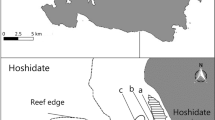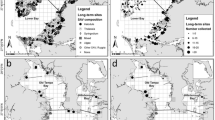Abstract
Few studies have validated the use of artificial seagrass to study processes structuring faunal assemblages by comparison with natural seagrass. One metric (fish recruitment) for evaluating the use of artificial seagrass was used in the present study. Settlement and recruitment of juvenile fish was estimated in natural, Zostera capricorni Aschers, and artificial seagrass in Botany Bay, NSW, over 6 consecutive days. Tarwhine, Rhabdosargus sarba, dominated the catch from both habitats, and there was no significant difference in abundance of recruits among the habitats. This was at least partly caused by large spatial and temporal variation in abundance. Daily abundances of R. sarba recruits suggested movement between seagrass beds, but could not be confirmed without tagging individual fish. Rhabdosargus sarba settlers were less abundant than recruits, but were also patchily distributed amongst natural and artificial seagrass beds. Most other species were also found in similar abundance in the two habitats, except stripey, Microcanthus strigatus, which was more abundant in artificial seagrass. Overall, fish assemblages in natural and artificial seagrass were similar. Artificial seagrass may therefore be useful for monitoring settlement and recruitment of juvenile fishes to disturbed habitats, to predict the success of habitat remediation. However, if artificial seagrass is used to model processes occurring in natural seagrass, it is necessary to consider species-specific responses to the artificial habitat.
Similar content being viewed by others
References cited
Bell, J.D. & M. Westoby. 1986. Variation in seagrass height and density over a wide spatial scale: Effects on fish and decapods. J. Exp. Mar. Biol. Ecol. 104: 275-295.
Bell, J.D. & D.A. Pollard. 1989. Ecology of fish assemblages and fisheries associated with seagrasses. pp. 565-609. In: A.W.D. Larkum, A.J. McComb & S.A. Shepherd (ed.) Biology of Seagrasses, A treatise on the biology of seagrasses with special reference to the Australian region, Elsevier Science Publishers B.V., Amsterdam.
Bell, J.D. & D.G. Worthington. 1993. Links between estuaries and coastal rocky reefs in the lives of fishes from southeastern Australia. pp. 85-91. In: C.N. Battershill, D.R. Schiel, G.P. Jones, R.G. Creese & A.B. MacDiarmid (ed.) Proceedings of the Second International Temperate Reef Symposium, NIWA, Wellington, New Zealand.
Bell, J.D., A.S. Steffe & M. Westoby. 1985. Artificial seagrass: How useful is it for field experiments on fish and macroinvertebrates? J. Exp. Mar. Biol. Ecol. 90: 171-177.
Bell, J.D., M. Westoby & A.S. Steffe. 1987. Fish larvae settling in seagrass: Do they discriminate between beds of different leaf density? J. Exp. Mar. Biol. Ecol. 111: 133-144.
Bell, J.D., A.S. Steffe & M. Westoby. 1988. Location of seagrass beds in estuaries: Effects on associated fish and decapods. J. Exp. Mar. Biol. Ecol. 122: 127-146.
Bologna, P.A.X. & K.L. Heck. 1999. Macrofaunal associations with seagrass epiphytes: Relative importance of trophic and structural characteristics. J. Exp. Mar. Biol. Ecol. 242: 21-30.
Booth, D.J. & D.M. Brosnan. 1995. The role of recruitment dynamics in rocky shore and coral reef fish communities. Adv. Ecol. Res. 26: 309-384.
Carr, M.H. 1991. Habitat selection and recruitment of an assemblage of temperate zone reef fishes. J. Exp. Mar. Biol. Ecol. 146: 113-137.
Clarke, K.R. & R.H. Green. 1988. Statistical design and analysis for a biological effects study. Mar. Ecol. Prog. Ser. 46: 213-216.
Clarke, K.R. & R.M. Warwick. 2001. Change in marine communities: An approach to statistical analysis and interpretation. PRIMER-E Ltd, United Kingdom, 166 pp.
Connell, S.D. & G.P. Jones. 1991. The influence of habitat complexity on postrecruitment processes in a temperate reef fish population. J. Exp. Mar. Biol. Ecol. 151: 217-294.
Connolly, R.M. 1995. Effects of removal of seagrass canopy on assemblages of small, motile invertebrates. Mar. Ecol. Prog. Ser. 118: 129-137.
Crowe, T.P. & A.J. Underwood. 1998. Testing behavioural 'preference' for suitable microhabitat. J. Exp. Mar. Biol. Ecol. 225: 1-11.
Frederick, J.L. 1997. Post-settlement movement of coral reef fishes and bias in survival estimates. Mar. Ecol. Prog. Ser. 150: 65-74.
Hannan, J.C. & R.J. Williams. 1998. Recruitment of juvenile marine fishes to seagrass habitat in a temperate Australian estuary. Estuaries 21: 29-51.
Jenkins, G.P. & M.J. Wheatley. 1998. The influence of habitat structure on nearshore fish assemblages in a southern Australian embayment: Comparison of shallow seagrass, reefalgal and unvegetated sand habitats, with emphasis on their importance to recruitment. J. Exp. Mar. Biol. Ecol. 221: 147-172.
Jenkins, G.P., M.J. Keough & P.A. Hamer. 1998. The contributions of habitat structure and larval supply to broad-scale recruitment variability in a temperate zone, seagrass associated fish. J. Exp. Mar. Biol. Ecol. 226: 259-278.
Johnson, R.A. & D.W. Wichern. 1998. Applied Multivariate Statistical Analysis. Prentice-Hall, New Jersey, U.S.A. 816 pp.
Kenyon, R.A., N.R. Loneragan, J.M. Hughes & D.J. Staples. 1997. Habitat type influences the microhabitat preference of juvenile tiger prawns (Penaeus esculentus Haswell and Penaeus semisulcatus De Haan). Est. Coast. Shelf Sci. 45: 393-403.
Kenyon, R.A., M.D.E. Haywood, D.S. Heales, N.R. Loneragan, R.C. Pendrey & D.J. Vance. 1999. Abundance of fish and crustacean postlarvae on portable artificial seagrass units: Daily sampling provides quantitative estimates of settlement of new recruits. J. Exp. Mar. Biol. Ecol. 232: 197-216.
Leber, K.M. 1985. The influence of predatory decapods, refuge, and microhabitat selection on seagrass communities. Ecology 66: 1951-1964.
Lee, S.Y., C.W. Fong & R.S.S. Wu. 2001. The effects of seagrass (Zostera japonica) canopy structure on associated fauna: A study using artificial seagrass units and sampling natural beds. J. Exp. Mar. Biol. Ecol. 259: 23-50.
Levin, P.S. 1994. Fine-scale recruitment variation in temperate demersal fish: The importance of settlement versus postsettlement processes. Oecol. 97: 124-133.
Levin, P.S. & M.E. Hay. 1996. Responses of temperate reef fishes to alterations in algal structure and species composition. Mar. Ecol. Prog. Ser. 134: 37-47.
McNeill, S.E. & P.G. Fairweather. 1993. Single large or several small marine reserves? An experimental approach with seagrass fauna. J. Biogeog. 20: 429-440.
McNeill S.E., D.G. Worthington, D.J. Ferrell & J.D. Bell. 1992. Consistently outstanding recruitment of five species of fish to a seagrass bed in Botany Bay, NSW. Aust. J. Ecol. 17: 359-365.
Neira F.J., A.G. Miskiewicz & T. Trnski. 1998. Larvae of Temperate Australian Fishes: Laboratory Guide for Larval Fish Identification. University of Western Australian Press, Nedlands, WA. 474 pp.
Pinckney, J.L. & F. Micheli. 1998. Microalgae on seagrass mimics: Does epiphyte community structure differ from live seagrasses? J. Exp. Mar. Biol. Ecol. 221: 59-70.
Risk, A. 1997. Effects of habitat on the settlement and postsettlement success of ocean surgeonfish Acanthurus bahianus. Mar. Ecol. Prog. Ser. 161: 51-59.
Sale, P.F. & W.A. Douglas. 1984. Temporal variability in the community structure of fish on coral patch reefs and the relation of community structure to reef structure. Ecol. 65: 409-422.
Sogard, S.M. 1989. Colonization of artificial seagrass by fishes and decapod crustaceans: Importance of proximity to natural eelgrass. J. Exp. Mar. Biol. Ecol. 13: 15-37.
Sogard, S.M. & K.W. Able. 1994. Diel variation in immigration of fishes and decapod crustaceans to artificial seagrass habitat. Estuaries 17: 622-630.
Vigliola, L., M.L. Harmelin-Vivien, F. Biagi, R. Galzin, A. Garcia-Rubies, J. Harmelin, J. Jouvenel, L. Direach-Boursier, E. Macpherson & L. Tunesi. 1998. Spatial and temporal patterns of settlement among sparid fishes of the genus Diplodus in the northwestern Mediterranean. Mar. Ecol. Prog. Ser. 168: 45-56.
Virnstein, R.W. & M.C. Curran. 1986. Colonization of artificial seagrass versus time and distance from source. Mar. Ecol. Prog. Ser. 29: 279-288.
Williams, A.H., L.D. Coen & M.S. Stoelting. 1990. Seasonal abundance, distribution, and habitat selection of juvenile Callinectes sapidus (Rathbun) in the northern Gulf of Mexico. J. Exp. Mar. Biol. Ecol. 137: 165-183.
Winer, B.J., D.R. Brown & K.M. Michels. 1991. Statistical Principles in Experimental Design. McGraw-Hill, New York.
Worthington, D.G., M. Westoby & J.D. Bell. 1991. Fish larvae settling in seagrass: Effects of leaf density and an epiphytic alga. Aust. J. of Ecol. 16: 289-293.
Worthington, D.G., D.J. Ferrell, S.E. McNeill & J.D. Bell. 1992. Growth of four species of juvenile fish associated with the seagrass Zostera capricorni in Botany Bay, New South Wales. Aust. J. Mar. Freshwater Res. 34: 1189-1198.
Author information
Authors and Affiliations
Rights and permissions
About this article
Cite this article
Upston, J., Booth, D.J. Settlement and Density of Juvenile Fish Assemblages in Natural, Zostera Capricorni (Zosteraceae) and Artificial Seagrass Beds. Environmental Biology of Fishes 66, 91–97 (2003). https://doi.org/10.1023/A:1023246427710
Issue Date:
DOI: https://doi.org/10.1023/A:1023246427710




